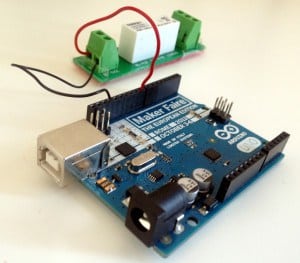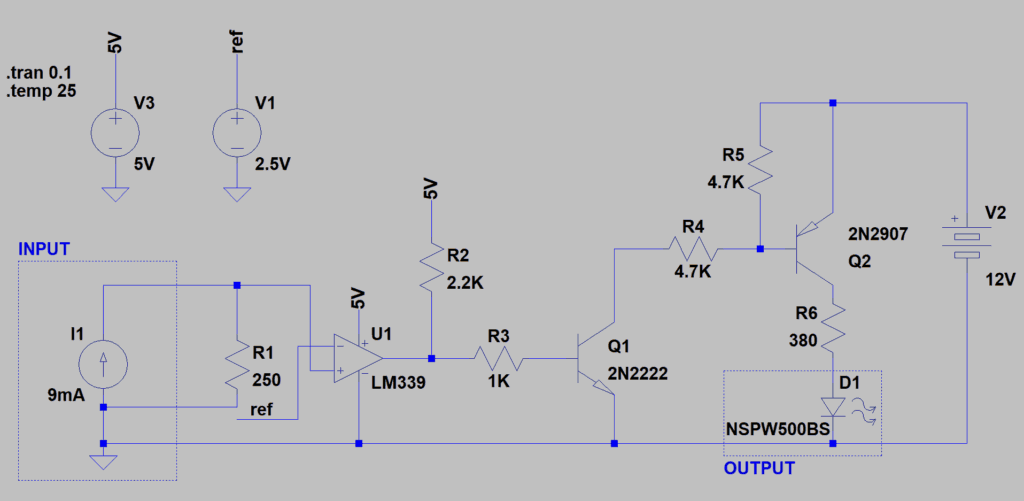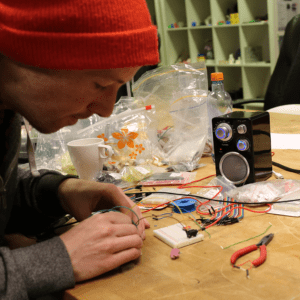Friday, 25 May 2018
Switching with molecules for pioneering electro-optical devices
Thursday, 24 May 2018
Understanding light-induced electrical current in atomically thin nanomaterials
Wednesday, 23 May 2018
Atomic-scale manufacturing now a reality
Beyond the limits of conventional electronics: Stable organic molecular nanowires
Tuesday, 22 May 2018
How a circuit simulator can help you understand any circuit
A circuit simulator is a tool for “seeing” what a circuit does. In comparison to mechanical machines such as a bicycle and a lever, electronics cannot be easily inspected by the naked eye.
When you look at a bicycle you can observe it and see that stepping on the pedals makes a chain turn, and that this chain moves the bicycle wheels.
In contrast, if you open up an audio amplifier, it will be really hard to tell what it does if you don’t have previous experience in designing and building electronic circuits.
Simulating To Understand A Circuit
Circuit simulators give you the flexibility to look at the voltage and current of every wire and component in a circuit.
If you are having trouble understanding a circuit, you can try drawing it up in a circuit simulator such as LTSpice (free). You can change the input voltage and components parameters and see how the circuit reacts. And this will give you an idea of what the circuit does.
Circuit Simulator Example
I’ve created a circuit that might be difficult to understand for electronics beginners. But by using a circuit simulator you can figure out the function of it and how its individual parts work:
Instead of having many images and long texts, I have made a video to go through the explanation of how to use LTSpice to figure out the function of this circuit. I am not telling you what it does, it’s in the video 
To download the simulation file click this link
Remember that you have to add the LM339 to the components library in order for the simulation to work.
How To Understand What A Circuit Does
In summary, in order to find out how a circuit works through simulation you should:
1. Think in terms of I/O:
If you are analyzing an analog circuit, then its main purpose will be to take an input signal, process it and output it as something else.
Find out what’s the input parameter, change its value and see how it affects the output. This way you will find out what’s the primary function of the circuit.
2. Divide the circuit into stages (if applicable):
Some analog circuits do more than one kind of processing, they could convert a current into a proportional voltage signal and then output another voltage to trigger a switch after a certain amount of time has passed.
Analog functions can do: conversion, switching, timing, filtering, amplifying, attenuating and more. In order to understand how your circuit works, divide it into stages so you can analyze each stage individually.
What you are basically doing is creating a smaller structure where you can apply the I/O principle again.
3. Analyze each stage:
Change the input parameter and the components values and see how it affects the output, probing different parts of the circuit. This way you will see and find out how this circuit works and relates to the rest of the bigger picture.
Hopefully, after reading this article and watching the video, you have one more tool in your arsenal as an electronics maker.
This was a guest post by Roberto Weiser. Please visit his website Developpa to find more useful circuit design tips that will help you both to understand electronics better and to complete your electronic product development. You can also join his mailing list to receive regular content and access to the downloadable resources.
Copyright Build Electronic Circuits
Monday, 21 May 2018
Flexible, highly efficient multimodal energy harvesting
Self-healing material a breakthrough for bio-inspired robotics
Friday, 18 May 2018
Keep the light off: A material with improved mechanical performance in the dark
Thursday, 17 May 2018
Researchers control the properties of graphene transistors using pressure
Wednesday, 16 May 2018
Glass-forming ability: Fundamental understanding leading to smart design
New device could increase battery life of electronics by a hundred-fold
Plug-and-play diagnostic devices
Monday, 14 May 2018
High-sensitivity microsensors on the horizon
Engineers on a roll toward smaller, more efficient radio frequency transformers
How a pinch of salt can improve battery performance
Shedding light on a cyclic molecule with a twist
Friday, 11 May 2018
Waterloo chemists create faster and more efficient way to process information
Thursday, 10 May 2018
Strain improves performance of atomically thin semiconductor material
Tuesday, 8 May 2018
Flexible, wearable oral sodium sensor could help improve hypertension control
Friday, 4 May 2018
Atomically thin magnetic device could lead to new memory technologies
Thursday, 3 May 2018
3-D batteries pack power into tiny footprints
My new favorite sound-creating chip
It’s one of my favorite things to do with electronics.
To create sound you need to make a circuit that makes a voltage go up and down very fast.
Like a few hundred (or even thousand) times per second.
In fine electronics term – an oscillator.
Connect this oscillating voltage to a speaker, and voila! You have sound.
To create oscillators, I’ve often used the 555 timer.
It’s relatively easy to build a circuit with it.
You can learn more about the 555 timer here:
https://www.build-electronic-circuits.com/what-everybody-ought-to-know-555-timer/
But understanding how it works isn’t straightforward for a beginner.
On Monday, Captain Credible and I had our second playdate.
We used a Schmitt-Triggered Inverter to create the base tone.
It’s a fancy-schmancy name, but it’s actually quite easy to understand the concept of it.
The base circuit we built was circuit number three from this article (only with smaller resistor and capacitor values):
https://www.build-electronic-circuits.com/blinking-led-circuit/
Then we added some fun circuitry to manipulate the sound and create some really cool effects.
I’ll upload a video of it soon.
But, after two playdates with Captain Credible, I am now convinced:
The Schmitt-Triggered Inverter is now my goto-chip for creating sound.
Keep On Soldering!
Oyvind @ build-electronic-circuits.com
Copyright Build Electronic Circuits
Custom silicon microparticles dynamically reconfigure on demand
Wednesday, 2 May 2018
Improving 3-D printing of plastic parts
Organic printing inks may restore sight to blind people
Arduino discount closing soon
 Earlier this month I published a new course bundle.
Earlier this month I published a new course bundle.
It’s called Getting Started With Arduino and includes four courses/tutorials to help you kickstart your Arduino learning.
For a few more days you can get it at 25% off.
All you need to do is to use the code TWENTYFIVEOFF:
https://learn.ohmify.com/p/getting-started-with-arduino-bundle/?product_id=612624&coupon_code=TWENTYFIVEOFF
You’ll learn to build things with the Arduino and start building projects with buttons, LEDs, mini speakers or displays.
It’s both fun and useful.
Keep On Soldering!
Oyvind @ build-electronic-circuits.com
Copyright Build Electronic Circuits
What is Blockchain? Working, History, Applications & Future
The power of existing ledgers is limited because the data stored on them can be altered or deleted. Therefore they cannot be trusted to provide a clear transparent image. There exists a gap of trust in current business transactions. This is why we depend on third parties to maintain our finances and ensure that our ledgers reflect our true operations. We cannot do business without them. What if we didn’t have to depend on third parties? What if we had some way to preserve the integrity of our ledgers on our own? That would eliminate the dependencies on all external intermediaries and empower individuals to manage their own affairs. This is exactly what blockchain can do for us. Blockchains are distributed ledgers that are open to everyone. Everyone can look at them, but once data has been created not even the editor can tamper with them. Blockchain functions like Wikipedia, anyone can alter the data in the blockchain and create new data. However, unlike Wikipedia, the data is not stored on a central server or regulated by a central party. Rather the data is stored in millions of computers worldwide and regulated by all the computers in the network. Once the data has been recorded inside the blockchain, it becomes extremely difficult to alter that data. In simpler words, a blockchain is a decentralized online ledger that records all transactions permanently without needing any authentication from any third party or intermediaries. How does Blockchain Technology Work? Blocks are the building blocks of the blockchain technology. Each block in the blockchain consists of three elements: Data Hash Previous Hash Data This is the information that has been stored inside the block. It varies from one blockchain to another. A blockchain containing the health record of the patient may record the temperature, blood pressure and heart rate of the patient at any particular time. Hash The Hash is the unique identification code of every blog. No two blocks in the blockchain can have the same hash code it is like the digital fingerprint of the blocks. If data inside the block is changed, the hash of the block changes as well thus creating a new block. This is what makes the blockchain so secure. Previous Hash Each block contains the hash of the previous block that it has evolved from. The common hash address between the newly created block and the original block is what creates the chain. It is this technology of digital stamping that makes the block chain so secure. For instance, suppose there are three blocks A, B and C. The first block, called Genesis block, is unique because it is the first one in the chain, therefore, it will not have a hash address of the previous block. The Blocks A, B and C are chained together due to the commonality in the hash address of two consecutive blocks. If someone tries to tamper block B and change the data stored on it, the hash address of block B will change. This will make the chain invalid as the hash address of block B will no longer correspond to the hash address of Block C. Such a change can easily be detected in the system. However, only hashing is not enough to keep the data secure. As modern computers are fast, hackers may override the whole chain by tampering with all the blocks in the chain and recalculating the hash codes. A mechanism called proof of work is used to add another layer of security to the blockchain. This mechanism slows down the creation of new blocks. In the...
read more
The post What is Blockchain? Working, History, Applications & Future appeared first on Electronic Circuits and Diagrams-Electronic Projects and Design.
Tuesday, 1 May 2018
Physicists find properties of magnetic soliton of interest for brain-inspired computing
Researchers develop recyclable, healable electronics
Electronics often get thrown away after use because recycling them requires extensive work for little payoff. Researchers have now found a w...
-
Do you need a MOSFET gate resistor? What value should it be? And should it go before or after the pulldown resistor? If you’re a bit impati...
-
I was first introduced to logic gates when I was around 14 years old. I had heard that computers consisted of ones and zeroes. But I didn’t...
-
CMOS (Complementary Metal Oxide Semiconductor) The main advantage of CMOS over NMOS and BIPOLAR technology is the much smaller power dis...

